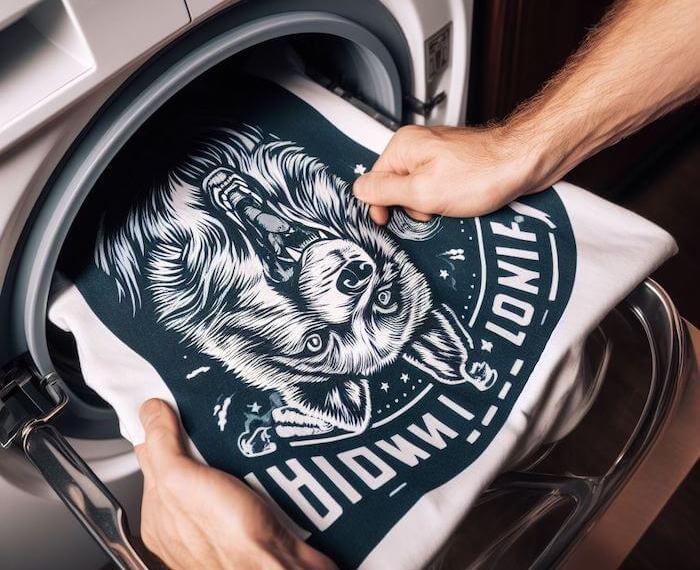Everyone loves the fresh look of a brand-new screen-printed shirt, crisp colors, sharp edges, and a smooth finish. But after a few washes, that print can start to fade, crack, or peel. The problem isn’t always poor-quality ink or printing — it’s usually the washing method.

Screen printing inks form a thin, cured layer on the fabric surface. When exposed to high heat, strong detergents, or constant friction, that layer breaks down over time. The result? A design that loses vibrancy and detail with every wash.
Why Screen Prints Fade Over Time Screen-printed designs are made of plastisol or water-based inks that cure (or “bake”) into fabric fibers. When washed in hot water or dried at high heat, those ink polymers soften and stretch, allowing tiny cracks to form. Over time, detergent chemicals and fabric friction widen those cracks, causing fading even if the print was originally high quality.
Fortunately, preventing this is simple. With the right washing routine, your screen-printed shirts can last for years while keeping their original color and texture.
This article explains why screen prints fade, how washing habits affect the ink layer, and what steps you can take to extend the life of every printed design.
Key Takeaways
Sort by similar fabrics, colors, and textures.
Washing shirts with fabrics of similar softness and weight reduces friction and ink damage. Keep cotton with cotton and avoid mixing with heavy items like jeans or towels to prevent cracking and color bleeding.
Turn shirts inside out before washing.
Protects the printed design from rubbing against other garments, reducing the risk of flaking or fading during the wash cycle.
Use cold water to prevent fading and cracking.
Keep wash temperatures below 30°C (86°F). Hot water softens plastisol inks, causing them to fade, peel, or distort.
Hand wash gently or use short cold cycles.
Hand washing minimizes agitation and extends print life. For machines, select short, cold cycles with mild detergent for best results.
Dry properly to preserve color and print quality.
Air dry shirts in the shade to prevent UV damage and fading. Avoid tumble dryers whenever possible — high heat and friction can dull or crack designs. If you must use a dryer, set it to the lowest temperature and remove heavy items first.
Avoid bleach and harsh detergents.
Strong chemicals strip pigments and weaken both ink and fabric fibers. Stick to enzyme-free, gentle detergents for lasting color.
Let’s now take a more specific look on how to care for your screen printed shirts and the right way to wash them!
Washing Screen Printed Shirts To Preserve Ink Vibrancy
Removing Wrinkles
A clean shirt deserves a smooth finish — but removing wrinkles from screen printed shirts requires care. The goal is to remove wrinkles without exposing the ink to high temperatures or direct pressure.
1. Effective steaming techniques to remove wrinkles
Use a handheld steamer on low heat while the shirt hangs inside out.
Steam around, not on, the print. Direct steam can soften plastisol or water-based inks, reducing their durability. For best results, steam both sides and sleeves to smooth the shirt evenly.
2. Ironing tips for wrinkle removal without damaging print design
Iron the shirt inside out using the lowest heat setting. Place a cotton cloth between the iron and the fabric.
For light fabrics, keep iron temperature below 120°C (250°F). Increase slightly only if wrinkles persist, and never iron directly on the print.
Final Care Tip
Even with the best care, every screen print tells a story over time. Slight fading or softness isn’t a flaw, it’s a sign of a well-loved shirt. But if you follow the right washing and storage habits, you’ll delay that aging process for years.
For designs that matter, whether it’s a brand logo or a one-of-a-kind graphic, treat each wash like part of the print’s lifecycle, not the end of it.
Top Questions About Washing Screen Printed Shirts
Q1. Can you wash screen printed shirts in a washing machine?
Yes, as long as you follow the right settings. Use cold water, choose a gentle or delicate cycle, and turn shirts inside out to minimize friction.
Avoid overloading the washer — heavy fabrics like denim or towels can rub against your print and cause cracking.
Pro tip: A mesh laundry bag can protect prints from zippers or buttons during the wash cycle.
Q2. What causes screen prints to crack or peel after washing?
Cracking usually comes from excessive heat, strong detergents, or friction — similar factors that contribute to print cracking and peeling in sublimation and other printing methods. Hot water softens the ink binder, while tumble dryers and irons apply too much stress to the design.
Using cold water and air drying prevents these problems. If you notice early cracking, try hand washing and drying flat to stop further damage.
Q3. How long do screen printed shirts last with proper care?
A well-printed shirt using quality plastisol ink can last 50–100 washes before showing noticeable fading, as long as it’s washed correctly.
Avoid heat, bleach, and rough washing cycles — those can cut that lifespan in half.
Proper storage in a cool, dry place keeps the print flexible for years.
